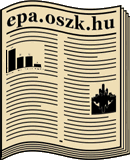Components of a Photographic Pictorial Structure and their Characteristics – through Examples of 20th Century Family Photographs
DOI:
https://doi.org/10.15170/PAAA.2022.09.01.05Keywords:
photography, image structure, depiction, image analysis, pictorial componentsAbstract
The private photograph can be interpreted as a complex medium. Which can capture a wide range of visible segments of the “reality” and the activities realized in it at a given moment. The associated memories, shaped into narratives, complement all of this with further information that illuminates the internal contexts of the pictorial content, the interpretation of the depicted situation, and its broader context. The set of content that sticks to the photos is therefore layered. The aim of this study is to systematically analyse the private photographs’ explicit content layers, i.e., the components of the visual information on the “surface” in order to reveal their properties influence the interpretation of the deeper content layers. To this end, to review the more important characteristics of time, space, persons, and events shaped into a two-dimensional visual element, the author uses as a source more than 2.000 family photographs, which material is a part of her visual ethnographic research related to lifestyle change.
Photo: From AI photo collection
Downloads
References
Andorka Rudolf: Bevezetés a szociológiába. Budapest, 2006.
Bán András: A privát fotó keresése In: Családi album. Vizuális antropológiai szöveggyűjtemény I. Szerk. R. Nagy József. Miskolc, 2000. 6–13.
Bán András: A vizuális antropológia felé. Budapest, 2008
.
Bartha Júlia: „Mosolyogni tessék!” - Egy nagykunsági család fotóhagyatékának tanulságai. In: Családok, famíliák, nemzetségek. A vérségi kapcsolatok szerepe a változó társadalomban. Szerk. Örsi Julianna. Túrkeve, 2003. 101–108.
Barthes, Roland: Világoskamra. Jegyzetek a fotográfiáról. Budapest, 1985.
Bourdieu, Pierre: A fénykép társadalmi definíciója. In: A sokarcú kép. Szerk. Horányi Özséb. Budapest, 1982. 226–244.
Chalfen, Richard: Snapshot Versions of Life. Philadelphia, 1987.
Freeman, John: A fotózás kézikönyve. Budapest, 2005.
Hirsch, Julia: Családi képek. Tartalom, jelentés, értelem In: Családi album. Vizuális antropológiai szöveggyűjtemény I. Szerk. R. Nagy József Miskolc, 2000. 70–110.
Kincses Károly: Pózkatalógus. Kultúra, kapcsolatok és a társadalmi helyzet tükröződése a 19. századi fényképeken. Budapest, 2006.
Kracauer, Sigfried: A fotográfia In: Fotóelméleti szöveggyűjtemény. Szerk. Bán András – Beke László. Budapest, 1997. 137–146.
Kunt Ernő: Nép-rajz és fotó-antropológia. Vizuális antropológiai jegyzetek paraszti használatú fényképekről. Ethnographia 98. (1987):1. 1–47.
Kunt Ernő: Fotó-antropológia. Fényképezés és kultúrakutatás. Miskolc–Budapest, 1995.
Marien, Mary Warner: A fotográfia nagykönyve. A fényképezés kultúrtörténete. Budapest, 2010.
Schacter, Daniel L.: Emlékeink nyomában. Az agy, az elme és a múlt. Budapest, 1998.
Szabó Magdolna: Egy özvegyasszony fényképgyűjteményéről – avagy a képek „törten” töretlen szentsége. Néprajz és Nyelvtudomány 37. (1996) 323–335.
Szabó Júlia: A tájrajz és a mintarajztanoda In: Utak és tanulságok. Válogatott művészettörténet tanulmányok és műkritikák. Szerk. Marosi Ernő. Budapest, 2014. 156–164.
Szalma Anna-Mária: Fénykép a mindennapi életben. Fényképkorpuszok antropológiai elemzése. Kolozsvár, 2014.
Tari János: Filmidő a néprajzi filmekben In: Vagabundus. Gulyás Gyula tiszteletére. Szerk. Biczó Gábor Miskolc, 2004. 323–338.
Terendi Viktória: Végvári pillanatképek. A spontán fényképek vizuális antropológiai értékéről. Honismeret 42. (2014):1. 45–47.

Downloads
Published
How to Cite
Issue
Section
License

This work is licensed under a Creative Commons Attribution-NonCommercial-NoDerivatives 4.0 International License.










